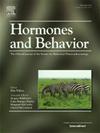先天性肾上腺增生症(CAH)的局部灰质改变
IF 2.5
3区 医学
Q2 BEHAVIORAL SCIENCES
引用次数: 0
摘要
先天性肾上腺皮质增生症(CAH)有报道表现为灰质畸变,但由于现有研究结果不一致,需要进一步研究。这些不一致可能是由于样本量小、样本组成差异(一些研究只包括女性)或分析的空间尺度(一些研究专注于选定的感兴趣区域)。在这里,我们编制了迄今为止最大的CAH样本,包括33名女性和20名男性,以及33名对照女性和20名对照男性,在性别、年龄、教育程度和语言智力方面。灰质在整个大脑中进行体素区域特异性检查,评估CAH和性别的主要影响,以及CAH与性别的相互作用(后者反映了产前雄激素暴露的影响)。与对照相比,患有CAH的个体在杏仁核、钙脑皮层(特别是初级视觉区)和海马体旁皮层(特别是耻骨下)内的灰质明显减少。性别也有主要影响,女性内侧额叶区域的灰质比男性多,小脑内男性的灰质比女性多。没有cah与性别的相互作用。我们的研究结果表明,CAH患者的区域灰质较少,这似乎是由医疗状况本身和/或糖皮质激素治疗引起的,而不是由产前雄激素暴露升高引起的。本文章由计算机程序翻译,如有差异,请以英文原文为准。
Altered regional gray matter in Congenital Adrenal Hyperplasia (CAH)
Congenital Adrenal Hyperplasia (CAH) has been reported to present with gray matter aberrations, but further research is required as the results of existing studies are inconsistent. These inconsistences might be due to small sample sizes, differences in sample composition (some studies only included females), or the spatial scale of the analyses (some studies focused on selected regions of interest). Here we compiled the largest CAH sample to date comprising 33 women and 20 men matched to 33 control women and 20 control men on sex, age, education, and verbal intelligence. Gray matter was examined with a voxel-wise regional specificity across the entire brain, assessing the main effects of CAH and sex, and the CAH-by-sex interaction (the latter reflecting effects of prenatal androgen exposure). Individuals with CAH had significantly less gray matter compared to controls within the amygdala, calcarine cortex (specifically the primary visual area), and parahippocampal cortex (specifically the subiculum). There also was a main effect of sex, with more gray matter in females than males in medial frontal regions and more gray matter in males than females within the cerebellum. There was no CAH-by-sex interaction. Our findings indicate less regional gray matter in individuals with CAH, which seems to be caused by the medical condition itself and/or its treatment with glucocorticoids, rather than by elevated prenatal androgen exposure.
求助全文
通过发布文献求助,成功后即可免费获取论文全文。
去求助
来源期刊

Hormones and Behavior
医学-行为科学
CiteScore
6.70
自引率
8.60%
发文量
139
审稿时长
91 days
期刊介绍:
Hormones and Behavior publishes original research articles, reviews and special issues concerning hormone-brain-behavior relationships, broadly defined. The journal''s scope ranges from laboratory and field studies concerning neuroendocrine as well as endocrine mechanisms controlling the development or adult expression of behavior to studies concerning the environmental control and evolutionary significance of hormone-behavior relationships. The journal welcomes studies conducted on species ranging from invertebrates to mammals, including humans.
 求助内容:
求助内容: 应助结果提醒方式:
应助结果提醒方式:


